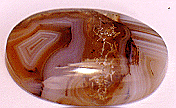

Occurence:
Worldwide.
Appearance:
Agate is a banded colored
stone found in nodular masses associated with volcanic lavas. The curved
banding is distinct from other forms of chalcedony. Agate, being porous,
is often dyed or stained. Large agates are often cut in half and dyed to
form attractive bookends. Agate occurs in a variety of forms, including
petrified wood, which has had it's organic matter replaced by agate.
Something Extra:No gemstone is more creatively striped by nature than agate, chalecedony quartz that forms in concentric layers in a wide variety of colors and textures. Each individual agate forms by filling a cavity in host rock. As a result, agate often is found as a round nodule, with concentric bands like the rings of a tree trunk. The bands sometimes look like eyes, sometimes fanciful scallops, or even a landscape with dendrite trees.
Agate was highly valued
as a talisman or amulet in ancient times. It was said to quench thirst
and
protect from fevers.
Persian magicians used agate to divert storms. A famous collection of two
to
four thousand agate bowls
which was accumulated by Mithradates, king of Pontus, shows the
enthusiasm with which
agate was regarded. Agate bowls were also popular in the Byzantine Empire.
Collecting agate bowls
became common among European royalty during the Renaissance and many
museums in Europe, including
the Louvre, have spectacular examples.
The following
are different colour of Agate:
- Blue Lace
Agate
- Botswana
Agate
- Crazy Lace
Agate
- Dendritic
Agate
- Dyed Agate
- Fire Agate
- Tree Agate